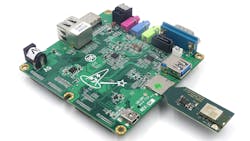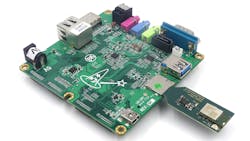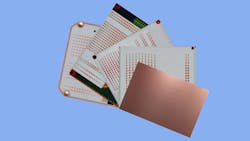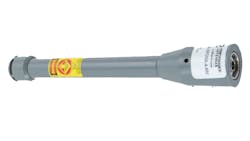Wireless technology plays a crucial role in today’s communications platforms and component development for next-gen devices and applications, including robotics, autonomous vehicles, drones, and the IoT. With the 5G rollout and the onset of Wi-Fi 6, manufacturers turn to the latest technologies to drive both hardware and software. In this roundup, we will take a look at the latest wireless platforms to hit the market before 2020 comes to a close.
Silicon Labs has released a new portfolio of pre-certified wireless modules with full-stack support and integrated device security; the modules are designed for IoT application development. The new modules include the xGM210PB, which features Arm’s Secure Vault device security and multiprotocol support for Zigbee, Bluetooth, and OpenThread. It’s also optimized for connected lighting, gateways, voice assistants, and smart meter in-home displays.
Silicon Labs’ BGM220 is a pre-certified Bluetooth 5.2 module that can operate for 10 years on a single coin-cell battery and is designed for a broad range of Bluetooth LE applications, including appliances, asset tags, beacons, portable medical, fitness, and Bluetooth Mesh low-power nodes. The MGM220 is a low-power module designed for eco-friendly IoT products, including lighting controls, and building and industrial automation sensors. The BGX220 Xpress module comes equipped with an integrated Bluetooth stack, Xpress command interface, and pre-programmed cable replacement firmware to provide serial-to-Bluetooth LE capabilities without any further firmware development.
For more information, visit the product webpage.
Laird Technologies recently announced its new Sentrius BT710 tracker, designed to provide organizations with real-time social distancing and contact tracing for personnel monitoring and safety. The Bluetooth tracker utilizes Bluetooth 5 and offers three user alerts for social-distancing notifications, including four highly visible LEDs, vibration, and a beeper. These notifications allow users to maintain a six-foot separation distance in real-time and provide tracker logs of any other BT710 tracking devices it has come in contact with, and its duration for contact tracing. Data can be downloaded from the tracker using the company’s MG100 BLE to cellular micro-gateway or the IG60 gateway, which also provides Wi-Fi, Ethernet, or cellular connectivity.
For more information, visit the product webpage.
NXP Semiconductor recently announced that its Wi-Fi and Wi-Fi/Bluetooth combos and i.MX RT MCU crossover processors are now supported within its MCUXpresso software, which simplifies product development. With this latest integration level, the company has expanded the connectivity capabilities of its EdgeVerse edge computing and security platform. By integrating driver support within the MCUXpresso SDK, NXP developers gain flexible and scalable solutions to help speed up compliance, shorten time to market, and streamline Wi-Fi or Wi-Fi/Bluetooth combo deployments. The pre-integrated Wi-Fi/Bluetooth drivers have been verified and tested. NXP provides several examples, including using the iPerf utility to test device-to-device performance, Wi-Fi Direct to scan and connect mobile devices to networks. They’ve also tasked it for use case development for IoT, industrial, automotive and communication infrastructure applications, and more.
For more information, visit the product webpage.
Shengyi Technology has developed a new PTFE-based, ultra-low insertion loss, controlled-dielectric printed circuit board (PCB) laminate dubbed mmWave77, which offers excellent electrical properties with stability over frequency, temperature, and environmental changes for a new level of reliability. mmWave77’s dielectric constant is 3.06 with an insertion loss of 1.29 dB/in (@77 GHz), based on a 0.127-mm (5-mil) dielectric thickness, 12-mil line width and H/H foil. mmWave77’s electrical properties have been designed to align with the industry-leading laminate choice for 77-GHz ADAS radars and feature a stable dielectric constant between -40℃ and +150℃ at up to V-band frequencies.
For more information, visit the product webpage.
KP Performance Antennas recently launched its new series of single-port omnidirectional Wi-Fi antennas designed to handle Wi-Fi (including new Wi-Fi 6 radios) applications, wireless video systems, 2.4-GHz and 5.8-GHz ISM bands, Bluetooth applications, IoT, and public safety. The series includes 13 models, which cover frequencies of 2.4 GHz, 5.8 GHz and dual-band antennas and feature a wide array of gain that ranges from 4 dBi to 15 dBi. The compact, lightweight design makes them ideal for tight spaces while retaining aesthetic appeal. They are also durable and economical, constructed with strong fiberglass for all-weather operation in cities and remote areas.
For more information, visit the product webpage.
About the Author
Cabe Atwell
Technology Editor, Electronic Design
Cabe is a Technology Editor for Electronic Design.
Engineer, Machinist, Maker, Writer. A graduate Electrical Engineer actively plying his expertise in the industry and at his company, Gunhead. When not designing/building, he creates a steady torrent of projects and content in the media world. Many of his projects and articles are online at element14 & SolidSmack, industry-focused work at EETimes & EDN, and offbeat articles at Make Magazine. Currently, you can find him hosting webinars and contributing to Electronic Design and Machine Design.
Cabe is an electrical engineer, design consultant and author with 25 years’ experience. His most recent book is “Essential 555 IC: Design, Configure, and Create Clever Circuits”
Cabe writes the Engineering on Friday blog on Electronic Design.






